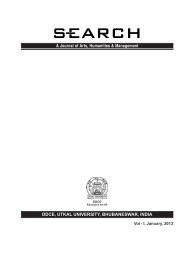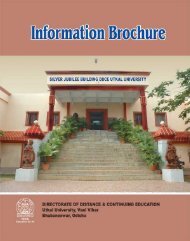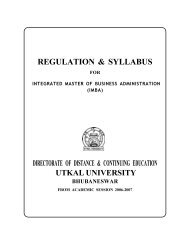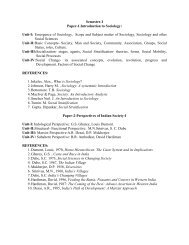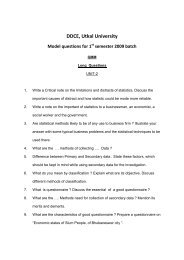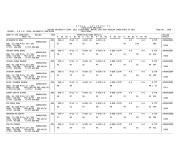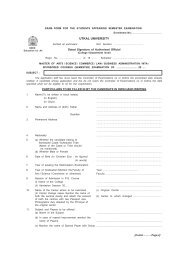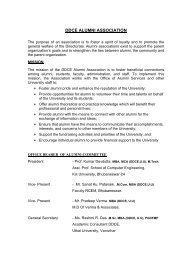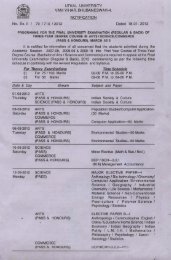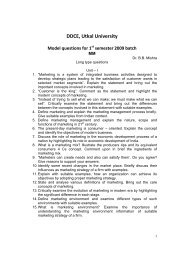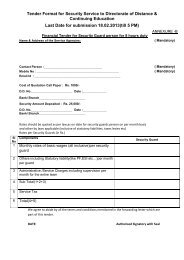Project Guidelines for 2yr MBA 4th Sem., All P G Diploma's 2nd Sem ...
Project Guidelines for 2yr MBA 4th Sem., All P G Diploma's 2nd Sem ...
Project Guidelines for 2yr MBA 4th Sem., All P G Diploma's 2nd Sem ...
Create successful ePaper yourself
Turn your PDF publications into a flip-book with our unique Google optimized e-Paper software.
PROJECT GUIDELINES FOR<br />
2 YR <strong>MBA</strong> 4TH SEMESTERS, ALL<br />
P G DIPLOMA’S 2ND SEMESTER AND I<strong>MBA</strong> 10TH SEMESTER STUDENTS<br />
Prepared by<br />
Dr. S. K. Acharya<br />
Lecturer <strong>MBA</strong><br />
DDCE<br />
UTKAL UNIVERSITY<br />
BHUBANESWAR<br />
AND<br />
Rashmi Ranjeeta Das<br />
Academic Consultant<br />
DDCE<br />
UTKAL UNIVERSITY<br />
BHUBANESWAR<br />
DIRECTORATE OF DISTANCE & CONTINUING EDUCATION<br />
UTKAL UNIVERSITY.
Content<br />
Chapter 1 – General <strong>Guidelines</strong><br />
Chapter 2 – <strong>Project</strong> Work <strong>Guidelines</strong><br />
Chapter 3 – Writing the Report<br />
Chapter 4 – Evaluation of the <strong>Project</strong> Report<br />
Chapter 5 – <strong>Project</strong> Areas and Topics<br />
Annexure :<br />
1. Initial Joining Report Format<br />
2. Completion Report<br />
3. Feedback Form<br />
Page 2
CHAPTER – 1<br />
GENERAL GUIDELINES<br />
1. On the project training is an integral part of the 24 months <strong>MBA</strong> programme of the Directorate.<br />
2. The period <strong>for</strong> the training is 28 days.<br />
3. No student is allowed to change the organization of training assigned to him/her without prior<br />
written permission of the Faculty-in-Charge. In case such a thing happens, the <strong>Project</strong> will be<br />
considered invalid.<br />
4. The training is aimed at the following objectives:<br />
a. To provide an extensive exposure to the student and hands-on experience in a corporate<br />
environment<br />
b. To ensure that the corporate gets adequate return from the student in terms of the money and<br />
time they spent on them during the training so that there is a mutual return of experience and<br />
learning<br />
c. To provide a plat<strong>for</strong>m <strong>for</strong> the corporate to test the reliability, quality and per<strong>for</strong>mance of the<br />
student and make a match <strong>for</strong> final job offer later, if they so deem fit.<br />
5. During the training the student will be under the supervision of a person in the organization who will<br />
act as his corporate guide and will provide guidelines <strong>for</strong> the corporate work during the stay of the<br />
student in the organization.<br />
6. The student will be required to abide by the rules of the organization where he/she is undergoing<br />
training.<br />
7. The corporate organization will be taking a strong view of the punctuality and behaviour of the<br />
student during the training and there<strong>for</strong>e the student will be required to be on their best behaviour<br />
and inculcate the good norms of the organization where they take the training.<br />
8. In case the student has to take leave of absence, he/she will have to take permission from the<br />
organization and the faculty guide be<strong>for</strong>e they proceed on leave.<br />
9. In case the student has to take up project based work at the instance of the company, they should<br />
conduct it to their best of their capability. The faculty guide will be always available <strong>for</strong> advice and<br />
guidance.<br />
10. No student should try to copy or use in<strong>for</strong>mation in such a way that will project false and baseless<br />
conclusions <strong>for</strong> the company. <strong>All</strong> students are required to maintain strict confidentiality regarding<br />
any in<strong>for</strong>mation they come across in the organization in the course of their training. In case such<br />
malpractice is found out, the student shall be duly penalized.<br />
11. <strong>All</strong> the students have to prepare and submit a written project at the time of the examination. It is<br />
not necessary <strong>for</strong> it to be a statistical or analytical report. It could be learning and experience<br />
sharing too. The project report would have to be certified by the organization. The details of<br />
designing a project work and carrying out the project work is mentioned in the Chapter 3.<br />
12. The details of the Evaluation of Summer training experience and the project work is mentioned in<br />
Chapter – 4.<br />
Page 3
2.1. WHY PROJECT WORK?<br />
CHAPTER – 2<br />
PROJECT WORK – GUIDELINES<br />
<strong>Project</strong> Work is the best way to practice what you have learnt. The purpose of including project<br />
report in the Programme is to provide you an opportunity to investigate a problem applying<br />
management concept in a scientific manner. It enables you to apply your conceptual<br />
knowledge in a practical situation and to learn the art of conducting a study in a<br />
systematic way and presenting its finding in coherent report. As managers, you are<br />
constantly seeking in<strong>for</strong>mation to base your decision. How well you collect, synthesize and make<br />
the data meaningful is what you learn through this process.<br />
2.2. WHAT IS PROJECT?<br />
A project is a scientific and systematic study of real issue or a problem intended to resolve the<br />
problem with application of management concept and skills. The study can deal with a small or<br />
big issue in a division or an organization, the problem can be from any discipline of management.<br />
The essential requirement of a project is that it should entail scientific collection, analysis<br />
and interpretation of data to valid conclusions.<br />
2.2.1. How to undertake project work<br />
Step 1 – Once the approval is received you can start project work. Thereafter project<br />
report should be prepared and submitted at the time of the examination.<br />
Step 2 – After evaluation of your project report by the examiner you will be called <strong>for</strong><br />
viva - voce.<br />
2.2.2. Criteria <strong>for</strong> selection of projects<br />
2.2.2.1. Topic should be selected from your MAJOR area of specialization.<br />
2.2.2.2. <strong>Project</strong> work should preferably be concerned with the organization.<br />
2.2.2.3. It should try to resolve the problem assessed in your project work.<br />
Defining the project will be easier if you use the following acid test. A project should ideally meat these criteria.<br />
• Will the implementation of the project bring about an<br />
improvement in the present status of an activity and<br />
can this improvement be quantified<br />
• Quantification may be in terms of money, or better<br />
utilization of time and manpower, better sales<br />
per<strong>for</strong>mance, higher production etc.<br />
• Does it have an underlying management principle,<br />
framework or model based on which the data is<br />
collected, analysed and argument developed?<br />
• Is the project idea applicable in other similar situations?<br />
In other words, development of the idea of thesis,<br />
proving or disproving of a hypothesis the methodology,<br />
the framework <strong>for</strong> analysis should be such that it can<br />
be applied to other problems of similar nature. While it<br />
would have a distinctive of its own in its application to<br />
the specific situation the project would not be so<br />
exclusive that its principles have no other applications.<br />
• Does the project report take into account factual data<br />
which is relevant to the situation?<br />
The <strong>Project</strong> Work undertaken should be authentic and should contribute towards the<br />
development and growth of the subject. If the Expert Committee feels that the <strong>Project</strong> Work<br />
undertaken does not appear to be authentic or does not contribute towards the growth of the<br />
subject or it has been merely copied from some sources, the Institute has the right to reject the<br />
<strong>Project</strong> Work summarily. In that case, the student may be asked to resubmit the <strong>Project</strong>.<br />
Page 4
2.3. TOPIC AND ORGANISATION<br />
A journey of a thousand miles begins with the first step. The first step of the project work is to<br />
choose a suitable topic <strong>for</strong> study. This choice will be entirely personal emerging from your area of<br />
interest. There can be more than one area of interest and there can be more than one topic in<br />
each area. When faced with such a wide choice a discussion with your colleagues, superiors or<br />
guide can help you in narrowing down your choice through elimination. While selecting the topic<br />
you have to take into account the organisation you work in and the opportunities you have at your<br />
command to generate relevant data. Having narrowed the scope of your topics apply the criteria<br />
shown above to make a final selection.<br />
A problem need not be an extraordinary one or out of the blue. You will find that many issues<br />
related to the working situation demand the systematic study. Some illustrative examples are<br />
attached at appx. (You are to select topic preferably acceptable to target organisation). You have<br />
to choose an organisation <strong>for</strong> your project work. This should preferably be your own or any other<br />
organisation in the vicinity. In any case, it would be one where you have access to in<strong>for</strong>mation<br />
and opportunity to discuss your ideas and views with the executives working there. The project<br />
outline and its <strong>for</strong>mulation must be freely discussed with those who are responsible <strong>for</strong> similar<br />
activities in the organisation you have selected <strong>for</strong> your project work.<br />
2.4. THEORETICAL PERSPECTIVES<br />
Be<strong>for</strong>e you start your project it is essential to carry out a preliminary survey of the available<br />
literature on the topic. This study will help in understanding the problem in depth and the aspects<br />
which are being investigated and will provides ideas <strong>for</strong> further research. You should consult the<br />
bibliographies of project report in libraries and skim through some reports on similar topics. An<br />
access to this in<strong>for</strong>mation will help you in crystallizing the design of your study and exploring the<br />
uncovered areas. However, it would be advisable not to repeat studies conducted earlier. An<br />
originality of approach in studying a topic will provide vitality to your project.<br />
Some studies require the statement of hypothesis. A hypothesis is a tentative diagnosis or<br />
solution to a problem. It is based on cursory observation of the apparent date and adopt<br />
provisionally to explain certain events and to guide the investigation of others. The project then<br />
would be based on testing the hypothesis to verify or reject it, <strong>for</strong> example, in a study of<br />
increasing absenteeism in a factory, one may propound the hypothesis that “absenteeism is on<br />
the increase because of lack of adequate welfare activities. On studying the problem in depth it<br />
may be proved to be so otherwise. A hypothesis then starts somewhere at the midpoint of<br />
research, <strong>for</strong>m here on can look back to the problem and also look <strong>for</strong>ward to the data. While<br />
writing your report you have to discuss the theoretical background in one of the first few chapters.<br />
These chapters will provide the frame work of your project report.<br />
2.4.1. Defining the Problem (Illustration)<br />
Title of the project: “Cost reduction through materials management”.<br />
Statement about the project:<br />
This particular topic is chosen because in most of the manufacturing organization the cost of materials account <strong>for</strong> a<br />
sizeable portion of the total expenditure and any savings affected in cost of material will have a direct bearing on the<br />
profitability of the organization.<br />
Objectives and scope of the study:<br />
• To optimize individual and group ef<strong>for</strong>ts <strong>for</strong> achieving the organization.<br />
Page 5
• To minimize cost of materials in every possible way, without sacrificing the quality aspect at the same time.<br />
• To maximize overall profitability of the enterprise so as to sustain and grow in the highly competitive<br />
environment satisfying the need of the organization, individual as well as the society at large stay with a few<br />
well chosen aspects so that it can studied and analysed thoroughly to get a deeper understanding. Trying to<br />
cover too much ground may lead to a very superficial analysis which weakens the project.<br />
Title: Cost reduction through Materials Management.<br />
Statement about the problem<br />
Comment<br />
You will note that the scope as defined is extremely diffused “Optimization of individual and group ef<strong>for</strong>t” is a human<br />
relation oriented problem, but this is a study in materials. Again “to maximize overall profitability of the enterprise” a<br />
material is one of the factors but certainly not all the factors.<br />
So what is the problem?<br />
Is it one of reducing material cost as defined in the introductory paragraph?<br />
Or is it of improving individual and group per<strong>for</strong>mance?<br />
Or is it one of maximizing profitability?<br />
Each one can independently <strong>for</strong>m a problem <strong>for</strong> a project.<br />
You argue that these are inter-related matters and there<strong>for</strong>e, cannot be ruled out. You would be right. But while<br />
others may be included at the managerial decision stage, at the project chosen <strong>for</strong> this project, material costs<br />
constitute 40% of the total working capital. The project is aimed at studying means of reducing this cost through<br />
more efficient materials management methods.<br />
Objectives and Scope of the Study:<br />
• Identify the major item of material cost through ABC analysis.<br />
• Identify reactors leading to high inventory and longer turnover period.<br />
• Devise means of reducing of material cost by taking care of the problem identified through improved<br />
procedures, systems and team ef<strong>for</strong>ts wherever necessary.<br />
2.5. METHODOLOGY<br />
The quality of your project work will depend upon the methodology you adopt <strong>for</strong> your study.<br />
Methodology in turn depends upon the nature of the project work. The main strength of your<br />
report comes from the process earlier mentioned that of collecting, synthesizing and analyzing<br />
in<strong>for</strong>mation which must have a bearing on the defined problem. Again, all in<strong>for</strong>mation, related to<br />
the problem needs to be carefully scrutinized to avoid risk of biased analysis.<br />
Having once identified which in<strong>for</strong>mation is relevant and need to be collected, you will have to<br />
define how this will be done. Thus, a case study may require a different approach than a study<br />
based on survey. However, where the volume of data is very large a sampling method needs to<br />
be adopted. The following steps then become necessary.<br />
2.5.1. Methodology<br />
ILLUSTRATION 1<br />
<strong>Project</strong> Title : “Corporate Planning : Current Status in India”<br />
Methodology :<br />
After providing a theoretical underpinning it is intended to review important corporate planning decisions of selected company. It<br />
always proposed to highlight the role of the Government policies in deciding the course of events the companies are <strong>for</strong>ced to<br />
take and economic events which had direct bearing on the corporate planning process in the past. It is decided to analyze a few<br />
case studies <strong>for</strong> successful growth as well as prominent failures.<br />
Comments :<br />
Unacceptable. Too vague. Need to define framework <strong>for</strong> generating data. How many companies are under study? Over what<br />
length of time-two years, five years, fifty years?<br />
ILLUSTRATION II<br />
Page 6
<strong>Project</strong> Title : “Application of CPM techniques in Capital Repair Shop”<br />
Methodology :<br />
List the various activities involved in the repair in consultation with the executing agencies.<br />
Estimation of duration of each activity through analysis of records and interaction with executives of the work shop.<br />
Drawing up of a network.<br />
Conducting <strong>for</strong>ward pass and backward pass calculations of establish the critical and sub critical activities.<br />
Taking into consideration the resources available to various agencies to carry out resources smoothly to arrive at the balanced<br />
requirement of resource throughout the repair period.<br />
Attempt will also be made to carry out the time cost relationship of activities so as to achieve the minimum possible/ optimum<br />
duration of the project.<br />
COMENTS :<br />
Acceptable<br />
2.5.2. Sampling: Size and coverage of the population providing data. Good sampling is done<br />
through statistical techniques. To refresh from the books mentioned at the end.<br />
2.5.3. Preparation of a pro<strong>for</strong>ma or a Questionnaire <strong>for</strong> Collection of Data: A technique<br />
that one should learn is the farming of a proper questionnaire. Most books on statistics or<br />
research methodology provide guidelines <strong>for</strong> farming a questionnaire.<br />
2.5.4. Pilot study or Pre-testing: A trial run of a questionnaire or some preliminary interviews<br />
helps in finalizing the structure of the questionnaire or the interviews.<br />
2.5.5. Processing of Data: Proper tabulation, classification, analysis, interpretation and<br />
comparison are essential steps in the processing of the data.<br />
2.5.6. Framework <strong>for</strong> Analysis: The framework <strong>for</strong> analyzing the data will be related to your<br />
stated objectives hypothesis. Statistical method can be used <strong>for</strong> analysis where<br />
applicable. Methodology of the project must be clearly thought out in as much detail as<br />
possible. Clarity in method helps in completing the project report expeditiously. In the box<br />
are given some illustration of methodology, both acceptable and unacceptable.<br />
(You must be extra careful that your method dose not gives rise to a whole lot of irrelevant data)<br />
2.6. PROJECT GUIDE’S ROLE (MERNTORS)<br />
As you proceed with your project work, you are likely to feel the need <strong>for</strong> a person who can act as<br />
a sounding board <strong>for</strong> your ideas. These may be in the designing of a questionnaire, structure<br />
your interview, deciding the size of sample, procedure <strong>for</strong> data collection, tabulation and analysis.<br />
For this you must approach a suitable person in your organization or environment who agrees to<br />
be your guide <strong>for</strong> the project work. Such a person should not only be well versed in contemporary<br />
management thinking but also have practical experience in the area of your study, you must<br />
discus your project design with your guide be<strong>for</strong>e the start of your project and again during the<br />
necessary and finally at the stage of writing the report. You should show him the draft project<br />
report be<strong>for</strong>e it is finalized <strong>for</strong> submission.<br />
An acknowledgement letter <strong>for</strong>m the <strong>Project</strong> Guide stating that the project work<br />
undertaken is authentic and satisfactorily conducted under his guidance has to be<br />
attached with the <strong>Project</strong> Repot.<br />
Page 7
3.1. WRITING THE REPORT<br />
CHAPTER – 3<br />
WRITING THE REPORT<br />
Once you have done the analysis of your data or have logically put together your case, you can<br />
get on with the task of writing the project. Be<strong>for</strong>e going to the main chapters, some peripherals<br />
yet important consideration to note are described below.<br />
3.1.1. COVER PAGE<br />
The cover page on the bound copy of the report should indicate<br />
3.1.1.1. The title of the report. It would be short and written in capital letters. If necessary, it<br />
should be followed by an explanatory sub-title.<br />
3.1.1.2. The name of the student and enrolment number<br />
3.1.1.3. Name and designation of the faculty member who has guided you.<br />
3.1.1.4. Name and designation of the person of the organisation who has guided you.<br />
An illustrative example of the cover page is given<br />
Page 8
PROJECT REPORT<br />
On<br />
DESIGNING OF PERFORMANCE APPRASIAL SYSTEM<br />
FOR NON-MANAGERIAL STAFF OF COMMERCIAL ORGANISATIONS<br />
SUBMITTED TO THE<br />
DIRECTORATE OF DISTANCE & CONTINUING EDUCATION<br />
IN PARTIAL FULLFILLMENT OF THE<br />
MASTER IN BUSINESS ADMINISTATION<br />
by<br />
Name : …………………………………………<br />
University Roll No : …………………………….<br />
En.Rollment No…………………………………….<br />
Regn.No……………………………………………….<br />
Under the<br />
Guidance of<br />
Name of Internal Guide Name of External Guide<br />
Designation Designation<br />
DIRECTORATE OF DISTANCE & CONTINUING EDUCATION<br />
UTKAL UNIVERSITY.<br />
3.1.2. Certificate from the organization (to be issued by the organization and the photocopy<br />
of the certificate is to be attach)<br />
Page 9
3.1.3. Certificate from the Guide. (<strong>for</strong>mat of the certificate)<br />
Mentor / Guide Name :<br />
Designation :<br />
CERTIFICATE OF THE GUIDE<br />
This is to certify that the project report entitled “____________________________________________”<br />
has been prepared by Ms./Mr.____________________________________________ under my<br />
supervision and guidance, <strong>for</strong> the fulfillment of Master In Business Administration. His/Her field work is<br />
satisfactory.<br />
Date: Signature of Guide<br />
3.1.4. Preface and Acknowledgments: In case you have received assistance from a person or<br />
a source in any from such as in the collection of data, facilities <strong>for</strong> interviews or<br />
references to record in connection with your project and own a special debt to particular<br />
source or person, you should acknowledge this under the title acknowledgments. Or else<br />
you may include these acknowledgments in the final paragraph of the preface or <strong>for</strong>ward<br />
which should highlight the objective of the study and the major problem you deal with in<br />
the report which follows in the succeeding pages.<br />
Page 10
ACKNOWLEDGEMENT<br />
It is really a great pleasure to have this opportunity to describe the feeling of gratitude imprisoned in the core of<br />
my heart.<br />
I convey my sincere gratitude to AGM (HR)/ _________________ <strong>for</strong> giving me the opportunity to prepare my<br />
project work in __________________. I express my sincere thanks to all the staff members of<br />
_____________________________________.<br />
I am thankful to ______________________________ <strong>for</strong> her/his guidance during my project work and sparing<br />
her/his valuable time <strong>for</strong> the same.<br />
I express my sincere obligation and thanks to all the Faculties of DDCE ____________________________ <strong>for</strong><br />
their valuable advice in guiding me at every stage in bringing out this report.<br />
I am also thankful to my family <strong>for</strong> their kind co-operation which made my take easy.<br />
3.1.5. Declaration (<strong>for</strong>mat of the Declaration)<br />
3.1.6.<br />
DECLARATION<br />
Name:<br />
Roll No:<br />
I do hereby declare that this project work entitled “__________________________________________”<br />
submitted by me <strong>for</strong> the partial fulfillment of the requirement <strong>for</strong> the award of Master In Business<br />
Administration(<strong>MBA</strong>) is a record of my own research work. The report embodies the finding based on<br />
my study and observation and has not been submitted earlier <strong>for</strong> the award of any degree or diploma to<br />
any Institute or University.<br />
Date: Name:<br />
Roll No:<br />
Page 11
3.1.7. Table of contents: Also called INDEX, the table should provide the title of all chapters<br />
(with page numbers) major subdivisions and appendices. The table should also indicate<br />
the commencing page numbers of the preface, the bibliography appendices & annexures.<br />
3.1.8. Main report: You main report should follow the chapter scheme you had indicated in<br />
your synopsis. Generally the sequential presentation should be as follows:-<br />
3.1.8.1. Chapter-I: Introduction of the problem: this chapter should provide a<br />
background of the problem and what is proposed to be investigated. The<br />
significance of the problem, the objective and the scope of the study and the<br />
contribution and impact your study will make should be elaborated. A brief<br />
description of the organization where you have conducted the project should<br />
be provided.<br />
3.1.8.2. Chapter-II: Theoretical Perspective: This chapter should give an overview of<br />
the theoretical concepts related to the problem under study. You should<br />
refer to the current status of research in the area and major finding thereof.<br />
These should bring out the necessity <strong>for</strong> a study of the kind you have<br />
undertaken and the approach you intend to follow.<br />
3.1.8.3. Chapter-III: Methodology: This chapter should describe in detail the steps<br />
followed in completing the study. If you have done a sample survey, the<br />
basis of sampling its size etc. should be discussed. The sources of primary<br />
and secondary data must be stated and the way you have processed the<br />
data should be elaborated.<br />
3.1.8.4. Chapter-IV, V, VI …. Onwards: Presentation of the relevant data and analysis<br />
and discussion thereon from the main body of the report. As you defined the<br />
problem-Clearly and definitely, be<strong>for</strong>e you start the report, decide on the<br />
main theme of your report; which of the findings are significant, which are<br />
peripheral? Develop your argument logically to build your theme, presenting<br />
data wherever necessary. Decide the distribution and the number of chapter<br />
required; keep appropriate balance in the size of the chapter, and avoid<br />
uneven coverage. Only include those parts of atable in the chapter which are<br />
relevant to the arguments, the details can be in the appendix. Spend more<br />
time on the central issues, giving them importance, clarity and emphasis. <strong>All</strong><br />
issue treated in the same manner dilute a report.<br />
3.1.9. Appendices and Annexures: Appendices are listed alphabetically e.g.<br />
Appendix A Appendix B etc. and contain the table and data collection <strong>for</strong> the<br />
study .They are not included in the main chapters but referred to in the<br />
discussion and interpretations. Appendices are placed after the last chapter<br />
on summary conclusions.<br />
Page 12
Annexures are numbered numerical e.g., Annexure II etc. and contain such<br />
supporting in<strong>for</strong>mation which through not collected as primary and<br />
secondary data, yet is relevant in discussion and <strong>for</strong> easy reference.<br />
3.1.10. List of references: references can be mentioned either at the bottom of the<br />
appropriate page where these are referred or at the end or each chapter. If<br />
this has not been done, a third alternative is to list them at the end of the<br />
report immediately after the appendices / Annexures.<br />
3.1.11. Bibliography: A bibliography is a list of published sources consulted during<br />
the course of project work and normally includes all work listed in the text<br />
and text notes. The bibliography can be listed in alphabetical order or split<br />
into two separate list each covering books and articles.<br />
3.1.12. Size of the project report: Depending upon the problem and data, a project<br />
report should be covered between 60 to 100 (double space). Each page must<br />
be typed in one side, leaving a wide margin.<br />
3.1.13. Reviewing & and Presentation: While writing and presenting a report, take<br />
care of minor matters as this will make it more professional. Badly edited<br />
reports with grammatical errors and wrong punctuations give a very poor<br />
impression. A well written and carefully corrected one holds the interest of<br />
the reader. Foolscap pages with single space matter needs a lot of grit and<br />
determination to read. Well spaced pages with proper headings, margins and<br />
tables are inviting.<br />
It is necessary to review and revise your draft report be<strong>for</strong>e you give to the<br />
final typing. Also show it to your guide and obtain his comments and<br />
suggestion <strong>for</strong> changes where necessary.<br />
Note: 1. Four copies of project report have to be prepared. Two copies the student has to<br />
submit to the concern authority notified <strong>for</strong> the purpose and One copy the student<br />
has to submit to the concerned organisation and the Other one he / she has to<br />
keep with him / her <strong>for</strong> further requirements. The student should bring the copy<br />
when he / she will present himself/herself <strong>for</strong> viva voice.<br />
2. One self copy of the <strong>Project</strong> Report is to be submitted into Library.<br />
3. Kindly follow the same <strong>for</strong>mat <strong>for</strong> cover page of project report as shown above.<br />
4. It is necessary to attach an acknowledgement letter from the project guide.<br />
Page 13
4.1. EVALUATION OF THE REPORT<br />
CHAPTER – 4<br />
EVALUATION OF PROJECT REPORT<br />
The evaluation of the project report will be done in two phases viz. - the written report and the<br />
viva-vice. The project report sent by you is sent to an examiner conversant with the subject<br />
matter of the report. The assessment of the report is done on standard criteria. Please study the<br />
criteria and the weight age given to each be<strong>for</strong>e you begin your project work.<br />
4.2. VIVA-VOCE<br />
Once your report has been evaluated by the examiner, you are called <strong>for</strong> a discussion of the<br />
report. The discussion normally takes the <strong>for</strong>m of elaborating your view points, your findings and<br />
overall view of the subject. The duration of this viva-voce is about 10-20 minutes. <strong>Project</strong> Viva<br />
will be conducted by Expert Committee appointed by DDCE. Students are required to give<br />
viva of the <strong>Project</strong> Work preferably through power point presentation.<br />
The viva-voce provides and opportunity to the examiner to test your knowledge of areas relevant<br />
to the subject of the report to elicit more in<strong>for</strong>mation about the techniques employed during field<br />
work and to ask <strong>for</strong> explanations and clarification where necessary. The viva voce will also give<br />
you an opportunity to know any flaw in your report and to have suggestion and guidance <strong>for</strong> any<br />
further work in the area of your study.<br />
Be<strong>for</strong>e you present yourself <strong>for</strong> the viva you must read your report and prepare yourself <strong>for</strong> any<br />
queries concerning your report. You must become aware of the deficiencies in your report and<br />
should be able to discuss them with your examiner.<br />
Note: 1. Kindly carry a copy of your project report.<br />
2. It is mandatory to bring identity card <strong>for</strong> viva voce.<br />
3. It is necessary to attach an acknowledgement letter from the <strong>Project</strong> Guide.<br />
4.3. EVALUATION CRITERIA FOR PROJECT WORK<br />
A. Written Report (60)<br />
Choice of subject/Title 05<br />
Clarity about objectives scope and coverage of the study 10<br />
Design of the study and methodology, Review of earlier work/literature available <strong>for</strong> the subject, data collection primary,<br />
secondary : questionnaire used where applicable, field work 10<br />
Analysis and Interpretation of data: Data Processing technique (manual/computer) quantitative OR other tools made use of. 10<br />
Innovative technique/approach to problem solving 10<br />
Finding of Research Study; recommendations, suggestions, policy issues 05<br />
Report writing and presentation; languages, composition & chapter scheme. 05<br />
Usefulness of the Study; applicability in business/industry, in decision making/system development. 05<br />
B. Viva-Voce (40)<br />
Page 14
Identification of the problem. Clarity about objectives, scope and coverage of the study 10<br />
Ability to discuss the report design, methodology instruments used literature connected with the report,<br />
data quality analysis and interpretation findings and recommendations 10<br />
Depth of the subject and conceptualization of the key areas after completing the project work 10<br />
Linking the Report Recommendations with project objectives and how far these have been achieved 05<br />
Draw back in the report if any and general comments 05<br />
Note: 1. In case of project reports relating to development of concepts and systems or case studies,<br />
ability to critically review the literature and development of thought process will be judged.<br />
2. Time required <strong>for</strong> viva voce cannot be laid down. It can last from 15 to 30 minutes or even 45<br />
minutes depending upon the particular case.<br />
Page 15
5.1. BUSINESS ADMINISTRATION<br />
1. Business failure in India<br />
2. Role of small-scale enterprise in<br />
Industrial development<br />
3. Styles of management in India<br />
4. Management techniques in public sector<br />
undertakings<br />
5. Corporate Strategy<br />
6. Just in Time Management.<br />
7. Business & Government<br />
8. Public Sector Enterprises<br />
9. Social Responsibilities of management<br />
10. Business policies<br />
11. Communication in Industry<br />
12. Leadership in Industry<br />
13. Attitude & Morals<br />
14. Executives Development Programme<br />
15. Public Utility Services<br />
16. Developing data bank on technologies in<br />
selected Industries in India<br />
17. Communication<br />
18. Tourism in India<br />
19. Producers, dealers, consumers behavior<br />
under Contemporary marketing<br />
20. Conditions.<br />
21. Sales and Distribution Management<br />
22. Marketing – A system approach<br />
23. Woodwork furniture <strong>for</strong> houses and<br />
offices.<br />
24. Develop a distribution model <strong>for</strong> a<br />
medium size firm.<br />
25. Role of public undertakings in the<br />
development of nation.<br />
26. Advantages and Facilities Available at<br />
Delhi dry port.<br />
27. A study of the Delhi Cake market.<br />
28. Marketing of Television in India.<br />
29. Employees Per<strong>for</strong>mance.<br />
30. Business Ethics<br />
31. Environmental Analysis<br />
32. Re-engineering<br />
5.2. FINANCIAL MANAGEMEN/ BANKING<br />
AND INSURANCE MANAGEMENT<br />
1. Technical tools <strong>for</strong> security analysis.<br />
2. Cost Control & Cost Reduction.<br />
3. Financial incentive <strong>for</strong> small industries.<br />
4. <strong>Project</strong> Appraisal & Finance<br />
CHAPTER - 5<br />
PROJECT AREAS<br />
5. Financial ratios of selected public sector<br />
undertakings.<br />
6. Determination of share price in stock<br />
market.<br />
7. Financial Statement Analysis.<br />
8. Share Market related subjects.<br />
9. ABC Analysis.<br />
10. Fundamental Analysis.<br />
11. NPA in commercial Banks investors’<br />
awareness regarding Demat Account.<br />
12. Awareness of Insurance product.<br />
13. PMRY Programme.<br />
14. NAV calculation of Mutual Funds &<br />
Centralized Insurance Products.<br />
15. Per<strong>for</strong>mance analysis of Mutual fund.<br />
16. Relevance of Stock exchange.<br />
17. New age Banking.<br />
5.3. HR MANAGEMENT<br />
1. Worker’s participation in management.<br />
2. Training and Development procedures.<br />
3. Trade Union Movement in India.<br />
4. Collective Bargaining.<br />
5. Per<strong>for</strong>mance Appraisal.<br />
6. Motivating employees.<br />
7. Discipline in the Industry.<br />
8. Wage Incentives<br />
9. Personnel Systems and Practices.<br />
10. Industrial conflict.<br />
11. Welfare activities in Industries.<br />
12. Industrial Relations in India.<br />
13. Leadership.<br />
14. Human Relations in Managerial Function.<br />
15. Communication.<br />
16. Business & Labour Laws.<br />
17. Discipline in Industry.<br />
18. Absenteeism<br />
19. Strikes & Lock outs.<br />
20. Transfer and promotional policies.<br />
21. Manpower planning.<br />
22. Grievance handling.<br />
23. Employees’ participation.<br />
24. Employees Turnover.<br />
25. IR climate in Indian states.<br />
26. Organizational culture.<br />
27. HRD systems / Climate<br />
28. Potential Appraisal.<br />
29. Per<strong>for</strong>mance Appraisal<br />
30. Employees Efficiency.<br />
Page 16
31. Organizational changes & Re-structuring.<br />
32. Job Satisfaction.<br />
5.4. MARKETING MANAGEMENT<br />
1. Marketing cost in India.<br />
2. Distribution costs in the Indian economy.<br />
3. Motivating sales man.<br />
4. The role of Consumer’s Production<br />
Group; their reference to the Indian<br />
marketing scene.<br />
5. Cost-benefit analysis says of<br />
(Newspaper) advertising <strong>for</strong> Consumer<br />
goods with special relevance to the level<br />
of sales at which they become an<br />
acceptable cost. Alternative promotional<br />
choice open to the small marketer.<br />
6. A critique on the advantages of the<br />
national marketing Strategy <strong>for</strong> a<br />
product of your choice vis-à-vis. Regional<br />
marketing.<br />
7. Dealer network <strong>for</strong> consumer durables.<br />
8. Distribution costs in marketing in Indian<br />
scene.<br />
9. Develop a Distribution Model <strong>for</strong> medium<br />
size firm.<br />
10. Field <strong>for</strong>ce management.<br />
11. Marketing of computer stationary in<br />
India.<br />
12. Point’s preserver of national Assets<br />
marketing A view point.<br />
13. Role of small-scale Industries growth,<br />
per<strong>for</strong>mance and prospects.<br />
14. Marketing of Anodised name plates.<br />
15. Consumer attraction and marketing of<br />
colorful flooring tiles & wall-Covering<br />
16. Market survey <strong>for</strong> PVC floor.<br />
17. Servicing of Automobiles in India.<br />
18. Electronics materials & Components.<br />
19. Public Sector Enterprises in India.<br />
20. Marketing of Dictation system.<br />
21. Marketing Problems faced by the small<br />
scale Industry.<br />
22. Marketing of Fertilizer by Cooperatives.<br />
23. Marketing of Cement with Specific<br />
Reference to Cement Corporation of<br />
India.<br />
24. Measuring the efficiency of advertising<br />
25. Different aspects of consumers Behavior<br />
26. Measuring Brand equity.<br />
27. Marketing & Management of In<strong>for</strong>mation<br />
services in India.<br />
28. Marketing of Pharmaceutical Products in<br />
India.<br />
29. Introduction of a new product in the<br />
market.<br />
30. The role of small scale Enterprises in<br />
Industrial Development.<br />
31. Setting up a small scale Television<br />
Assembly Unit.<br />
32. Marketing Problems and Prospects of<br />
Indian Tractor Industry.<br />
33. Market Survey on GLS Lemps.<br />
34. Problems and Aspects of Indian<br />
Pharmaceuticals Industry.<br />
35. Marketing cost of silk in India.<br />
36. Sugar marketing in India.<br />
37. Marketing cost of aluminum In India<br />
38. Marketing channel decisions.<br />
39. Retail Management<br />
40. Role of IT in Marketing<br />
5.5. Systems<br />
1. Inventory Management.<br />
2. Office Automation System.<br />
3. ERP System<br />
4. CRM System.<br />
Note: The Students are at full liberty to<br />
select any other topic (with consultation with<br />
the concerned Mentor/guide), not mentioned<br />
above, as long as it pertains to their<br />
discipline.<br />
Page 17
DIRECTORATE OF DISTANCE & CONTINUING EDUCATION<br />
UTKAL UNIVERSITY<br />
BHUBANESWAR<br />
www.ddceutkal.org<br />
INITIAL JOINING REPORT<br />
1. Name of the Student : ___________________________________________________<br />
2. Roll No : ___________________________________________________<br />
3. Name of the Company : ___________________________________________________<br />
4. Address of Communication : ___________________________________________________<br />
___________________________________________________<br />
___________________________________________________<br />
___________________________________________________<br />
5. <strong>Project</strong> Title : ___________________________________________________<br />
6. <strong>Project</strong> Description : ___________________________________________________<br />
___________________________________________________<br />
___________________________________________________<br />
7. Date of Joining : ___________________________________________________<br />
8. Name of the <strong>Project</strong> Guide : ___________________________________________________<br />
a. Designation : ___________________________________________________<br />
b. Address : ___________________________________________________<br />
___________________________________________________<br />
___________________________________________________<br />
c. Telephone numbers : ___________________________________________________<br />
d. Mobile number : ___________________________________________________<br />
e. Email address : ___________________________________________________<br />
Page 18
Name of the student:<br />
Roll No:<br />
Name of the company:<br />
DIRECTORATE OF DISTANCE & CONTINUING EDUCATION<br />
UTKAL UNIVERSITY<br />
BHUBANESWAR<br />
www.ddceutkal.org<br />
COMPLETION REPORT<br />
I have completed my assignment(s) on _______________ (date) and have also handed over<br />
all my reports materials, files and books to the satisfaction of my project guide, departmental head<br />
and the head of HRD. I have also submitted my final summer project to the company along with<br />
the project presentation.<br />
Signature of the student<br />
With Date<br />
Signature of <strong>Project</strong> Guide Signature of Departmental Head<br />
With Date and Seal With Date and Seal<br />
Page 19
Name of the student :<br />
Roll No :<br />
<strong>Project</strong> Title :<br />
01. Please tick the appropriate Box:<br />
Sl<br />
No<br />
DIRECTORATE OF DISTANCE & CONTINUING EDUCATION<br />
UTKAL UNIVERSITY<br />
BHUBANESWAR<br />
www.ddceutkal.org<br />
FEEDBACK FORM<br />
Parameter Exceptional Excellent Very Good Average Satisfactory<br />
01 Extent of conceptual<br />
reading and clarity<br />
02 Comprehension of the<br />
project<br />
03 Seriousness , sincerity<br />
& thoroughness in<br />
planning be<strong>for</strong>e the<br />
project<br />
04 Sense of responsibility<br />
and commitment<br />
05 Time and quality<br />
orientation<br />
06 Initiative, drive and<br />
enthusiasm<br />
07 Communication<br />
effectiveness and<br />
keeping the superiors<br />
in<strong>for</strong>med about the<br />
progress<br />
08 Acceptance and<br />
Learning from<br />
mistakes and seeking<br />
guidance from the<br />
experienced<br />
09 Depth of knowledge<br />
10 Quality of analysis and<br />
diagnosis<br />
11 Practicality of<br />
recommendation vis-àvis<br />
purpose of study<br />
Not<br />
Satisfactory<br />
Page 20<br />
Very Poor
12 Behaviour and conduct<br />
13 Discipline, punctuality<br />
and regularity<br />
14 Quality of reporting<br />
and presentation<br />
Contd…<br />
DIRECTORATE OF DISTANCE & CONTINUING EDUCATION<br />
UTKAL UNIVERSITY<br />
BHUBANESWAR<br />
www.ddceutkal.org<br />
02. Is the report useful to the Company : Yes _____ No _____<br />
03. Would you implement it? : Yes _____ No _____<br />
i. Is yes, to what extent and in what respects can you implement it?<br />
_____________________________________________________________________________<br />
_____________________________________________________________________________<br />
ii. If no, can you please specify the reasons <strong>for</strong> it?<br />
_____________________________________________________________________________<br />
_____________________________________________________________________________<br />
04. Have you observed any weaknesses he/she needs to correct, where Institute of Management<br />
Bhubaneswar (IMB) should pay attention?<br />
_____________________________________________________________________________<br />
_____________________________________________________________________________<br />
_____________________________________________________________________________<br />
05. Any aspect on which he/she should pay more attention to be more professional and attentive?<br />
_____________________________________________________________________________<br />
_____________________________________________________________________________<br />
_____________________________________________________________________________<br />
Date :<br />
Name :<br />
Page 21
Designation :<br />
Company :<br />
Tel No. :<br />
Fax no. :<br />
Email :<br />
Mobile no. :<br />
Signature with company seal<br />
Note: Submission schedule at DDCE Utkal University, Bhubaneswar(at the time of submission of Report)<br />
Page 22



